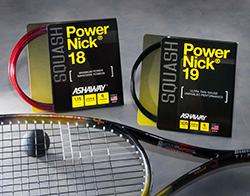|
|

Trends in Stringing III: Next Generation R & D
By Steve Crandall
Vice President, Sales & Marketing
Ashaway Racket Strings

The pros have demonstrated a decided preference for thinner strings for a number of years, migrating steadily from 17 gauge, to 18, and even to our PowerNick® 19 gauge, the thinnest string currently on the market. Our PowerNick family, which uses a new space-age PEEK polymer called Zyex®, provides excellent resilience and response, along with a dramatic increase in the ability to grip, cut, slice, and work the ball. |
If the past is prelude, then we can expect a couple things from the next generation of squash strings. First, they are going to be thinner. The pros have demonstrated a decided preference for thinner strings for a number of years, migrating steadily from 17 gauge, to 18, and even to our PowerNick® 19 gauge, the thinnest string currently on the market at 1.05 mm.
Thinner strings have several advantages. They dig a bit deeper into the surface of the ball, generating better grip for more spin and superior control. They create less swing resistance, allowing the racquet to move faster. And, they weigh less, which can also boost swing speed and racquet maneuverability. (I once weighed sets of 17 and 18 gauge strings of similar construction, and the difference was 1.82 grams, or 15% - not a huge difference, but maybe enough to be significant.)
However, thinner strings also tend to break more quickly than thicker ones of the same material. So the second thing we can look for in the next generation of thinner squash strings, is that they will require new technology, either in material and/or design, to stand up to the rigors of the game.
We've seen this play out with both our PowerNick 19, which uses a space-age PEEK polymer called Zyex®, and with our SuperNick® XL Micro, which uses a specially constructed nylon multifilament core with very high linear density and a double-braided multifilament jacket with a textured surface to provide durability and ball control.
So our R & D plan has been to expand our 19 gauge string offerings by incorporating whatever new material technology we can find with whatever design innovations we can come up with. We want to harness the benefits of these thinner gauges, while minimizing their limitations. People are always looking for something new that will give their game just that little extra edge, and we want to be the ones to provide it. With these things in mind, we turned the guys in the lab loose to see what they could come up with.
The first thing they came back with was a new proprietary material we're calling BETA Polymer, which has great resilience and provides superior bending and knot strength in thinner cross-sections (i.e., gauges). We've used this BETA polymer in badminton strings as thin as 22 gauge - that's 0.62 mm - and found it offers a 25% improvement in dynamic stiffness (resilience) and in knot and sheer strength over most popular badminton strings. Of course, badminton is not squash, and we don't yet know whether we can expect the same (or better?) results using BETA polymer in a 19 gauge squash string. So far, however, it's looking very positive.
Squash strings usually break in one of two ways. One is near the frame from off-center hits. This is not as common in squash as other racquet sports (the ball being so light) but it does happen more with some of the newer "high-tech" power racquet designs, and, of course, happens more with thinner strings. The improved bending and knot strength in our BETA Polymer will really help in this regard.
But the most common reason strings break is from abrasion. During play, the mains and crosses slide over each other, creating a sawing action that cuts right through the strings. As you can imagine, thinner strings wear faster than thicker ones, but this is compounded by the fact that thicker strings tend to lock more and slide less.
We're attacking this problem on two fronts. First, we're testing new coatings that will improve abrasion resistance. Second, we're looking at new wear layer constructions that will be either a) rougher, to lock the mains and crosses together more and limit the sawing action, or b) smoother, to reduce the sawing action by reducing the friction between the strings.
Which approach will provide the best durability and playability? We simply don't know yet. We do know from studies of tennis strings that smooth strings that stretch and snap back are better in generating spin. Will this also work in squash? My personal feeling is that if you get the surface too smooth, you will lose feel, because the ball is so light. But I don't think my personal feelings have anything to do with the physics involved. That's why we call it R & D. So stay tuned: we may both be surprised at what we come up with!
ZYEX® is a registered trademark of Victrex Ltd.
This article previously appeared in Squash Magazine.
|